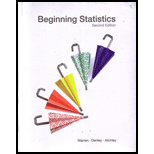
(a)
To find:
The null and alternative hypotheses.
Answer to Problem 19E
Solution:
The null hypothesis is
Explanation of Solution
Given information:
Lauren and Keri live in different states and disagree about who has higher electric bills. To settle their disagreement, the girls decided to sample electric bills in their area for the month of June and perform a hypothesis test that the mean monthly residential electric bill is higher for Lauren’s state than for Keri’s state. Is there evidence at the 0.01 Level to say that the mean monthly residential electric bill is higher for Lauren’s state than for Keri’s state.
The null hypothesis is a statement of no difference, that there is no significant difference between the two phenomena. It is considered to be true until it is nullified by statistical evidence for an alternative hypothesis.
An alternative hypothesis is a contradicting statement to the null hypothesis and states a significant difference between the two phenomena It is accepted when the null hypothesis is false.
Calculation:
From the given information:
Let
From the given information, the claim is to test that the residential electric bill is higher for Lauren’s state than for Keri’s state, i.e.
Therefore the null hypothesis is
(b)
To find:
Which distribution to be used for test statistic, and the level of significance.
Answer to Problem 19E
Solution:
The distribution used is standard normal variate (one-tailed z test), and the level of significance is 1% or 0.01.
Explanation of Solution
Since both the sample sizes are greater than 30,
According to the null hypothesis, one-tailed test is to be applied.
From the given information, the level of significance is 1% or 0.01.
(c)
To find:
The test statistic
Answer to Problem 19E
Solution:
The test statistic is 0.66
Explanation of Solution
Given information:
For Lauren’s state:
The
For Keri’s state:
The sample size is 51, the mean monthly electric bill is
Test statistics is a random variable which is calculated from the sample data and used in hypothesis testing.
Test statistic calculates the degrees of acceptance between sample data and null hypothesis.
Formula used:
The test statistic for a hypothesis test for two population means is:
Where:
and
Calculation:
The test statistic for a given hypothesis is,
Substitute
It is given that the null hypothesis for the given proportion is
Thus, the test statistic is
(d)
To find:
The conclusion by comparing the
Answer to Problem 19E
Solution:
The null hypothesis is accepted and it shows that there is no significant difference in the electric bills of the two companies.
There is insufficient evidence to say that the electric bill of the company in Lauren’s state is higher than by Keri’s state.
Explanation of Solution
Formula used:
The
Calculation:
This is a right-tailed test, so p-value = P
Conclusion:
Test statistic is
Since the
The null hypothesis is accepted and it shows that there is no significant difference in the electric bills of the two companies.
Want to see more full solutions like this?
Chapter 11 Solutions
Beginning Statistics, 2nd Edition
- A company found that the daily sales revenue of its flagship product follows a normal distribution with a mean of $4500 and a standard deviation of $450. The company defines a "high-sales day" that is, any day with sales exceeding $4800. please provide a step by step on how to get the answers in excel Q: What percentage of days can the company expect to have "high-sales days" or sales greater than $4800? Q: What is the sales revenue threshold for the bottom 10% of days? (please note that 10% refers to the probability/area under bell curve towards the lower tail of bell curve) Provide answers in the yellow cellsarrow_forwardFind the critical value for a left-tailed test using the F distribution with a 0.025, degrees of freedom in the numerator=12, and degrees of freedom in the denominator = 50. A portion of the table of critical values of the F-distribution is provided. Click the icon to view the partial table of critical values of the F-distribution. What is the critical value? (Round to two decimal places as needed.)arrow_forwardA retail store manager claims that the average daily sales of the store are $1,500. You aim to test whether the actual average daily sales differ significantly from this claimed value. You can provide your answer by inserting a text box and the answer must include: Null hypothesis, Alternative hypothesis, Show answer (output table/summary table), and Conclusion based on the P value. Showing the calculation is a must. If calculation is missing,so please provide a step by step on the answers Numerical answers in the yellow cellsarrow_forward
 MATLAB: An Introduction with ApplicationsStatisticsISBN:9781119256830Author:Amos GilatPublisher:John Wiley & Sons Inc
MATLAB: An Introduction with ApplicationsStatisticsISBN:9781119256830Author:Amos GilatPublisher:John Wiley & Sons Inc Probability and Statistics for Engineering and th...StatisticsISBN:9781305251809Author:Jay L. DevorePublisher:Cengage Learning
Probability and Statistics for Engineering and th...StatisticsISBN:9781305251809Author:Jay L. DevorePublisher:Cengage Learning Statistics for The Behavioral Sciences (MindTap C...StatisticsISBN:9781305504912Author:Frederick J Gravetter, Larry B. WallnauPublisher:Cengage Learning
Statistics for The Behavioral Sciences (MindTap C...StatisticsISBN:9781305504912Author:Frederick J Gravetter, Larry B. WallnauPublisher:Cengage Learning Elementary Statistics: Picturing the World (7th E...StatisticsISBN:9780134683416Author:Ron Larson, Betsy FarberPublisher:PEARSON
Elementary Statistics: Picturing the World (7th E...StatisticsISBN:9780134683416Author:Ron Larson, Betsy FarberPublisher:PEARSON The Basic Practice of StatisticsStatisticsISBN:9781319042578Author:David S. Moore, William I. Notz, Michael A. FlignerPublisher:W. H. Freeman
The Basic Practice of StatisticsStatisticsISBN:9781319042578Author:David S. Moore, William I. Notz, Michael A. FlignerPublisher:W. H. Freeman Introduction to the Practice of StatisticsStatisticsISBN:9781319013387Author:David S. Moore, George P. McCabe, Bruce A. CraigPublisher:W. H. Freeman
Introduction to the Practice of StatisticsStatisticsISBN:9781319013387Author:David S. Moore, George P. McCabe, Bruce A. CraigPublisher:W. H. Freeman





